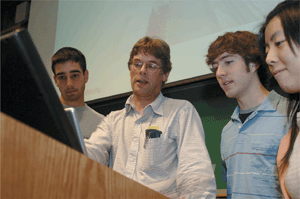

In Class
How Am I Doing?
Technology gives students, professors instant feedback. By Enid Arbelo
 TECH TOUCH: Frank Wolfs talks with Jonathan Kurvits ’10, Nate Stein ’10, and Rosa Wong ’10 before their physics class. Students in the class use a handheld device as part of a system called the Personal Response System to gauge how well they are comprehending course material.
TECH TOUCH: Frank Wolfs talks with Jonathan Kurvits ’10, Nate Stein ’10, and Rosa Wong ’10 before their physics class. Students in the class use a handheld device as part of a system called the Personal Response System to gauge how well they are comprehending course material.
When Laura Arnold ’10 prepares for her honors physics course, she packs a small electronic device along with her notebook. But it’s not a PDA or an iPod.
Known as the Personal Response System, the device is giving faculty like Frank Wolfs, a professor of physics, a new ability to gauge the progress—or lack thereof—of students.
“Communication has improved because of technology,” says Wolfs. “This way you get a more honest response about their progress.”
At the beginning of class, Wolfs quizzes the students using the system. The tool connects to the professor’s computer and notes responses to questions. The answers are recorded, analyzed, and displayed on a projection screen in an easy-to-read histogram.
The instant feedback decreases the amount of time professors or teaching assistants spend grading papers and instead allows them to know immediately how well their students are grasping the material. Although some students who find the subject matter difficult or confusing may not raise a concern or ask a question in class, thanks to the device, their confusion does not go unnoticed.
Wolfs uses several layers of technology in his class, and Arnold says that’s exactly how it should be.
“I couldn’t imagine physics without technology,” says Arnold. “I couldn’t fathom how they did physics prior to the computer. I give Newton props.”
Even homework in the class has gone high-tech. Students use WeBWorK, a Rochester-developed, freely distributed Web-based tool that gives immediate feedback on individualized problem sets, letting students know when their answers are right and when they are wrong.
“I hate the uncertainty with the written work,” Arnold says.
“No matter what tool you use for homework, nothing is perfect,” Wolfs notes. “But if students know they are wrong, they will try to get it right.”
WeBWorK, which was created by University mathematicians Michael Gage and Arnold Pizer, recently received a National Science Foundation grant of nearly $500,000.
The grant allows Gage and Pizer to expand and improve the program by making the interface more user-friendly. The program, used in math and in physics and astronomy courses at Rochester, also is used at more than 100 institutions nationwide, including large public and private research universities like Cornell and Columbia as well as community colleges and high schools.
The technology has become so popular because it has opened new levels of communication between professors and students, says Vicki Roth, director of learning assistance services and project evaluator for WeBWorK.
Professors who use the program are able to see who is struggling with the material, who is getting the answer right or wrong, and who is not attempting the homework at all.
With the traditional grading system, such monitoring was possible but not feasible because of class size and time constraints. In the past, Wolfs says, he would never have been able to have a weekly graded quiz because it would have taken too much time to create the test, grade it, analyze the scores, and share the results with students.
Now, students take the quiz with a touch of a button and the results follow shortly after.
In the end, even technology proponents like Arnold still value the one-on-one time with their professors. And even techno-savvy professors like Wolfs go back to the basics:
“Sometimes a good old-fashioned blackboard is still the best tool.”
